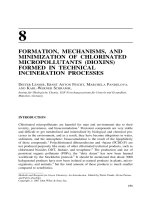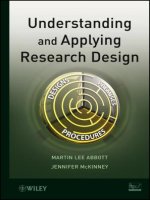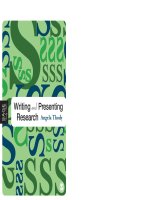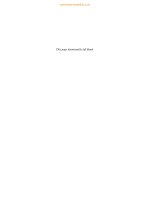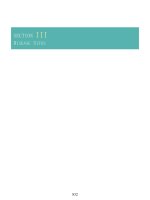Ebook Writing and presenting research: Angela thody – Part 1
Bạn đang xem bản rút gọn của tài liệu. Xem và tải ngay bản đầy đủ của tài liệu tại đây (2.47 MB, 123 trang )
00-Thody-Prelims.qxd
5/23/2006
3:39 PM
Page i
Writing and Presenting
Research
00-Thody-Prelims.qxd
5/23/2006
3:39 PM
Page ii
© Angela M. Thody, 2006
First published 2006
Apart from any fair dealing for the purposes of research or
private study, or criticism or review, as permitted under the
Copyright, Designs and Patents Act, 1988, this publication
may be reproduced, stored or transmitted in any form, or
by any means, only with the prior permission in writing of
the publishers, or in the case of reprographic reproduction, in
accordance with the terms of licences issued by the Copyright
Licensing Agency. Inquiries concerning reproduction outside
those terms should be sent to the publishers.
SAGE Publications Ltd
1 Oliver’s Yard
55 City Road
London EC1Y 1SP
SAGE Publications Inc.
2455 Teller Road
Thousand Oaks, California 91320
SAGE Publications India Pvt Ltd
B-42, Panchsheel Enclave
Post Box 4109
New Delhi 110 017
British Library Cataloguing in Publication data
A catalogue record for this book is available
from the British Library
ISBN-10 1 4129 0292 4
ISBN-10 1 4129 0293 2
ISBN-13 978 1 4129 0292 2
ISBN-13 978 1 4129 0293 9 (pbk)
Library of Congress Control Number: 2005934768
Typeset by C&M Digitals (P) Ltd, Chennai, India
Printed on paper from sustainable resources
Printed and bound in Great Britain by TJ International Ltd, Padstow, Cornwall
Study skills
SAGE
00-Thody-Prelims.qxd
5/23/2006
3:39 PM
Page iii
Writing and Presenting
Research Angela Thody
SAGE Publications
London
●
Thousand Oaks
●
New Delhi
00-Thody-Prelims.qxd
5/23/2006
3:39 PM
Page iv
Contents Overview
1 Conventions or
Alternatives?
page 3
Want to know what
style to go for? This
chapter helps you
sort it out
4 Adapting to
Audience: Adjusting
for your Purposes
page 49
Do you know your
aims? Will you reveal
them to your readers
and listeners? Is it
ethical to let audience
aims have priority
over yours?
7 Literature and
Methodology
page 89
Find out why you
need to include them,
what’s the right style
and how to organize
them
2 Principles for
Selecting Appropriate
Writing and
Presentation Styles
page 18
Follow this framework
from the first day
you start researching
a topic
5 The Arts and Craft
of Writing
page 58
From getting started
to proofreading, learn
how to cope with
everything from jargon
and colloquialisms to
tenses and tone
3 Adapting to
Audience: Adjusting
for their Aims
page 34
Your readers and
listeners really do
matter, so find out what
is wanted by academics
or less specialized
audiences, national or
international
6 Primary Data
page 79
Collected a mountain of
data? Find out how to
get it under control
8 Quantified Data
page 109
9 Qualitative Data
page 129
This is how to make
your numbers really
count. But without
forgetting that
the words matter too
It’s pretty crowded
with all those voices
to report. Here’s how
to make them really
expressive
00-Thody-Prelims.qxd
5/23/2006
3:39 PM
Page v
CONTENTS OVERVIEW
10 Narrative
Data
page 145
11 Beginnings and
Ends
page 159
Poetry, history, stories:
are you writing
a novel bestseller or
a research report?
Impact, guide, review,
impress. Discover the
significance of how
you start and finish
13 Becoming a
Presenter
page 203
14 Getting into Print
page 214
15 Copyright
page 221
Whether conventional
or alternative is your
style, find out how to
be effective
This is what you write
for so use this quick
reference guide to help
An introduction to
copyright and
intellectual property
16 Epilogue
page 235
17 Appendix:
Research Method
for this Book
page 238
Bibliography
page 241
Who supports my
belief about the
importance of, and
choices for, writing and
presentation?
Where do you fit in?
Author bio-data
Discover how I wrote
this book and what
were its antecedents
12 Citations:
Bibliographies,
Referencing, Quotations,
Notes
page 185
Getting it correct – the
final exciting challenge
All the text references and
further reading
v
00-Thody-Prelims.qxd
5/23/2006
3:39 PM
Page vi
00-Thody-Prelims.qxd
5/23/2006
3:39 PM
Page vii
Contents
List of Boxes
List of Figures
List of Tables
Hazard Warning
Appreciation
PART I
PREPARATION
xi
xiii
xiv
xv
xvi
1
1
1.1
1.2
1.3
1.4
1.5
1.6
1.7
Conventions or Alternatives?
Debates to resolve
Context of the debates
Conventional formats
Alternatives
Resolving the debates?
Chapter outlines
Review
3
3
6
7
10
14
16
17
2
2.1
2.2
2.3
2.4
2.5
Principles for Selecting Appropriate Writing and Presentation Styles
Framework of principles
Dialogue with the data
Writing and presenting
After writing
Review
18
18
18
24
31
33
3
3.1
3.2
3.3
3.4
3.5
3.6
3.7
3.8
Adapting to Audience: Adjusting for their Aims
The value of an audience
Attitudes to audience
Assessing readers and listeners
Academic audiences
Audiences outside academia
Academic and less specialist audiences combined
Acknowledging the power of readers and listeners
Review
34
34
35
36
38
42
44
47
48
4
4.1
4.2
4.3
Adapting to Audience: Adjusting for your Purposes
Contrasting purposes
Defining your purposes
Overt purpose: enhancing knowledge
49
49
50
50
00-Thody-Prelims.qxd
viii
5/23/2006
3:39 PM
Page viii
WRITING AND PRESENTING RESEARCH
4.4
4.5
4.6
4.7
Covert purposes: careers and finance
The overt and covert combined: influencing policy
Ethics
Review
51
52
55
57
5
5.1
5.2
5.3
5.4
The Arts and Craft of Writing
How easy is writing?
The writing process
Style and tone
Review
58
58
59
66
76
PART II
SELECTION AND REDUCTION
6
6.1
6.2
6.3
6.4
6.5
Primary Data
Selection and reduction
How little do you need?
Using the guiding principles to select and reduce data
Using categorization to select and reduce data
Review
7
7.1
7.2
7.3
7.4
7.5
Literature and Methodology
Literature reviews and methodology surveys: definitions
Literature reviews and methodology surveys: locations and extent
Literature reviews
Methodology surveys
Review
PART III
8
8.1
8.2
8.3
8.4
8.5
8.6
8.7
8.8
8.9
8.10
PRODUCTION
Quantified Data
Quantified data presentation: purposes
Quantified data presentation: the challenges
Qualitative and narrative data quantified
Reduction
Influencing readers
Supporting explanations
Language and style
Appearances
Ethics
Review
9
Qualitative Data
9.1 Polyvocality
9.2 Qualitative data writing and presentation: purposes
77
79
79
79
80
84
88
89
89
90
91
99
105
107
109
109
110
111
111
114
118
120
121
122
125
129
129
132
00-Thody-Prelims.qxd
5/23/2006
3:39 PM
Page ix
CONTENTS
9.3
9.4
9.5
9.6
9.7
9.8
9.9
Qualitative data formats
Observation data
Interview data
Focus group data
Historical, literary and legal data
Ethics
Review
132
133
135
139
141
143
144
10
10.1
10.2
10.3
10.4
10.5
10.6
Narrative Data
Definitions
Narrative’s allure
Narrative’s challenges
Getting started
Ethics
Review
145
145
146
146
156
158
158
11
11.1
11.2
Beginnings and Ends
Why beginnings and ends matter
Abstracts, executive summaries,
key points, prefaces
Acknowledgements, appreciation, forewords
Appendices
Author notes or bio-data
Bibliography, endnotes, references
Conclusions, summary, recommendations
Contents listings
Glossaries
Introductions
Keywords or descriptors
Quotations at the beginnings and ends of texts
Titles and title pages
Review
159
159
11.3
11.4
11.5
11.6
11.7
11.8
11.9
11.10
11.11
11.12
11.13
11.14
12
12.1
12.2
12.3
12.4
12.5
12.6
12.7
Citations: Bibliographies, Referencing, Quotations, Notes
Uses for citations
Major citation systems
End-of-text citations: bibliography, references, works cited,
further reading
In-text citations (what to put in those brackets)
Quotations in the text
Notes
Review
161
164
166
167
168
168
171
172
173
175
176
178
184
185
185
186
189
190
193
194
200
ix
00-Thody-Prelims.qxd
x
5/23/2006
3:39 PM
Page x
WRITING AND PRESENTING RESEARCH
PART IV
13
13.1
13.2
13.3
13.4
PUBLICATION: REFERENCE GUIDES
Becoming a Presenter
Challenges and opportunities
Conventions and alternatives
What’s effective for both conventional and alternative presentations?
Review
14
14.1
14.2
14.3
14.4
14.5
14.6
Getting into Print
Start-up
Journals
Chapters in edited books
Books
Success and rejection
Extending the audience for your research and publications:
using the web
14.7 Ten top tips: publish or perish
15
15.1
15.2
15.3
15.4
15.5
15.6
Standing on the Shoulders of Giants – Without
Violating their Copyright
Lora Siegler Thody and Serena Thody
General
Violation of copyright
Your own copyright
Libel and slander
Websites for reference
Authors’ bio-data
PART V
201
203
203
204
205
213
214
214
215
218
219
219
219
220
221
222
224
227
230
230
231
VALEDICTION
233
16
16.1
16.2
16.3
Epilogue
The debate
How the protagonists line up
Where you and I fit in
235
235
235
236
17
17.1
17.2
17.3
17.4
Appendix: Research Method for this Book
Inception of the project
Sources
Data analysis
Data presentation
238
238
238
240
240
Bibliography
241
Index
252
00-Thody-Prelims.qxd
5/23/2006
3:39 PM
Page xi
Boxes
1.1
1.2
2.1
Differentiating conventional and alternative research
writing styles: poetic format
Differentiating conventional and alternative research
writing styles: textbook format
4
5
2.2
2.3
2.4
2.5
Example of the same research data in both a primary (journal article)
and a secondary (crime novel) format by the same author
Template for the basics of a research report
Template for the basics of a university thesis
Research writing and presentation: dealing with the practicalities
After publication: marketing your research
21
22
23
30
33
3.1
Writing appropriately for less specialist audiences
43
4.1
Ways of reporting to research respondents
57
5.1
5.2
5.3
How to stop writers’ block
Proofreading
Using jargon
62
65
70
6.1
6.2
6.3
Reducing drafts
Data categories in tabular form
Selecting categories for your data
83
85
86
7.1
7.2
7.3
Purposes of literature reviews
Criticism in literature reviews
Template for methodology reviews
91
98
99
8.1
Criteria for evaluating quantitative formatting
125
9.1
9.2
Qualitative data writing and presentation: purposes
Writing and presenting individual interview data: requirements
132
135
10.1
Challenges to be met in the writing and presentation of narrative
147
11.1
11.2
Design criteria for beginnings and ends
Objectives for abstracts, executive summaries, key points, prefaces
160
162
00-Thody-Prelims.qxd
xii
5/23/2006
3:39 PM
Page xii
WRITING AND PRESENTING RESEARCH
12.1
12.2
12.3
12.4
Uses for citations
Citation and style systems: examples
In-text citations: what, where and how
Comparisons of citations in the text and citations
in notes
186
186
192
195
00-Thody-Prelims.qxd
5/23/2006
3:39 PM
Page xiii
Figures
2.1 Framework of principles to guide your selection of writing
and presentation styles
2.2 Contrasting formats for the title page of a conference paper
19
26
5.1
5.2
5.3
5.4
60
62
63
64
Starting writing
How to procrastinate
Do you need print versions of work-in-progress?
Techniques for drafting and redrafting
6.1 Illustration of data reduction: extracts from an advertisement for
a commercial product developed from research
80
7.1 Literature and methodology reviews for different
audiences and purposes
91
8.1 The effect of repositioning table titles and explanatory information
8.2 Four figures collated from one article, showing variety of
formats, sanserif font within the figures, column
alignment and differing title fonts and formats
11.1 Contrasting styles of title pages
115
123
182
00-Thody-Prelims.qxd
5/23/2006
3:39 PM
Page xiv
Tables
4.1
8.1
8.2
8.3
8.4
8.5
8.6
8.7
8.8
8.9
8.10
Extract from a research report: tabulated data from which
varying priorities were selected by different users
Purposes of quantified data writing and presentation (version 1)
Extract to illustrate quantified reduction of historical and
literary data: the incidence of terminological categorizations
of women
Extract to illustrate quantified reduction of observational data:
time spent alone by CEOs
Extract to demonstrate the presentation of a table without
accompanying text
Extract to demonstrate the presentation of a table with
accompanying repetitive text
Extract to demonstrate the presentation of a table with accompanying
non-repetitive text
Extract to demonstrate the presentation of a table with
accompanying explanatory text
Purposes of quantified data writing and presentation (version 2)
Descriptive Analysis of Schools Backgrounds and Teachers
Backgrounds (Ho, 2003: Table 2)
Descriptive Analyses of Schools’ and Teachers’
Backgrounds (revised version)
54
109
112
113
116
117
117
118
121
126
127
9.1
Conventions and alternatives for qualitative data polyvocality
131
11.1
Effective introductions
174
12.1
12.2
Bibliographical aims
Types of bibliographies
189
191
13.1
Comparisons between conventional and alternative presentations
206
00-Thody-Prelims.qxd
5/23/2006
3:39 PM
Page xv
Hazard Warning
Read in chapter order, this book presents a wide-ranging, introductory guide to the
choices to be made in deciding how to communicate research findings in documents
and presentations. Once you have familiarized yourself with the contents, the book
becomes a valuable reference.
The book is necessary because although pluralism in research methodologies has
become accepted, pluralism in the ways in which research can be reported is much less
accepted; nor are there many sources of information on the possible varieties of reporting research.
New researchers may find this book destabilizing if they have not previously confronted many choices of how to write up, or present, their research. Experienced
researchers may find this book causes arguments about cherished ideas concerning
what is, or is not, conventional for reporting research.
If you want to discuss the destabilizing or the arguments with me, do make contact:
Emerita Professor Angela Thody,
International Institute for Educational Leadership, University of Lincoln,
Brayford Campus, Lincoln LN6 7RS, England
00-Thody-Prelims.qxd
5/23/2006
3:39 PM
Page xvi
Appreciation
Many thanks to
generations of my students whose questions drove me to write this book;
those who have listened to my presentations, who read my publications and whose
comments drove me to envisage this book;
my family who were driven to distraction by this book and to Lora and Serena who
wrote one of its chapters;
my helpful publishers who steered my driving with their experience, particularly
Patrick Brindle, Brian Goodale, Vanessa Harwood and Rebecca De Luca Wilson;
the driving verve of the many writers and presenters whose examples are included in
this book, particularly Professors N.B. Jones and Esther Sui-Chu Ho, The Athena
Institute and Beth Bownes Johnson for permissions to use their excellent works, my
postgraduate students, Dr. Anat Oster, Hilda Mugglestone, Simon Testa and Gillian
Horsley for extracts from their theses in preparation and after completion, and
Professors Martin Barstow, Mike Cook, Michael Hough, Olof Johansson, Zoi
Papanaoum, Petros Pashiardis and Dr John Baker whose presentations inspired me;
Commonwealth Council for Educational Administration and Management for permission to reprint extracts from Ho Sui-Chu, E. (2003), Roberts, V. (2003), Stewart,
J.M. and Hodges, D. (2003), and Thody, A.M. and Nkata, J.L. (1997).
Professors Mike Cook, Betty Marchant and Mark Brundrett whose helpful reviews
drove me to improve the book;
my daughters, Amber and Serena, who assiduously hunted references for me when
my drive failed and to the author, Steve Coonts, who responded so promptly to my
queries;
my grandson, Sean, whose early arrival left me time to finish this book.
01-Thody-3390-Ch-01.qxd
Part I
5/23/2006
3:40 PM
Page 1
Preparation
01-Thody-3390-Ch-01.qxd
5/23/2006
3:40 PM
Page 2
01-Thody-3390-Ch-01.qxd
1
5/23/2006
3:40 PM
Page 3
Conventions or Alternatives?
CONTENTS
1.1
1.2
1.3
1.4
1.5
1.6
1.7
1.1
Debates to resolve
Context of the debates
Conventional formats
1.3.1 Definitions
1.3.2 Advantages
1.3.2.1 A training ground
1.3.2.2 Simplicity and comparability
1.3.2.3 Political, professional and academic acceptance
1.3.2.4 Globalization
Alternatives
1.4.1 Gaining acceptance?
1.4.2 Definitions
1.4.3 Reasons for emergence of alternatives
1.4.3.1 Postmodernism
1.4.3.2 Changing attitudes to the natural
and social sciences
1.4.3.3 New research and technical methodologies
Resolving the debates?
1.5.1 The middle ground
1.5.2 The guiding principles
Chapter outlines
Review
3
6
7
7
8
8
8
9
9
10
10
12
13
13
13
13
14
14
16
16
17
Debates to resolve
This book is a guide through the choices to be made when deciding how to report research,
principally in social sciences (including health), arts and humanities but also with relevance
to, and examples from, natural and applied sciences and law. It covers research written as
theses and dissertations, chapters, books, reports and articles in academic, professional or
general media such as newspapers. It reviews the options for presenting research orally as
lectures, keynotes, conference papers and even TV game shows.
All of these forms of reporting research have well established conventions for their
formats. All of them also have growing numbers of alternative possibilities. These have
generated debate about what is or is not acceptable. My aim is to make this debate more
01-Thody-3390-Ch-01.qxd
4
5/23/2006
3:40 PM
Page 4
WRITING AND PRESENTING RESEARCH
manageable for those wanting to assess which of the conventional formats (1.3) or alternative possibilities (1.4) on offer is most appropriate for reporting their current research.
This debate, polarizing conventions and alternatives, was encapsulated for me in a
conversation with fellow conference delegates following an academic’s word-for-word
reading aloud of his conventional research paper. The listeners’ views on the presenter
differed radically. I report this ‘mini’ research into their opinions as a poem in Box 1.1.
Box 1.1
Differentiating conventional and alternative
research writing styles: poetic format
Conference Debate
It’s like listening to poetry,
He said.
I go to a conference to hear the poetry of the paper;
The paper is like poetry read by the real, actual writer,
Word for word,
Like all papers,
He said.
I learn later from reading the paper,
But not at the conference.
There you only go to hear researchers as poets.
You hear them interpreting their own poetry of words,
Their nuances, their cadences, their enthusiasm.
They do not need to explain them to YOU.
It is enough to be close to academic celebrities,
He said.
It should be teaching,
She said.
I go to a conference to learn from the presentation of the paper,
It is research, explained by the originator,
Just the main issues,
Different styles,
She said.
(Continued)
01-Thody-3390-Ch-01.qxd
5/23/2006
3:40 PM
Page 5
CONVENTIONS OR ALTERNATIVES?
Box 1.1
(Continued)
You should comprehend from hearing a clear summary of the paper
There, at the conference.
You see researchers illuminating with PowerPoint,
Duplicated notes, pictures, sound, enthusiasm;
They feel the need to share with US.
So you are close to great teachers,
She said.
Angela Thody, 2005
Did my poem appeal to you, annoy you or intrigue you, as an ‘alternative’ way of
reporting research data? Is it appropriate for the opening of a textbook on research writing and presentation? Did the visual differences in the layout of the two verses add to,
or detract from, the message? Should the personal forms of ‘I’, ‘my’ and ‘you’ in this
chapter so far have been mixed with the impersonal (it, one)? These exemplify the types
of questions which this book explores.
To illustrate the opposite pole in this debate, the poem’s information in conventional,
‘textbook’ form is in Box 1.2. What is your reaction to this?
Box 1.2 Differentiating conventional and alternative
research writing styles: textbook format
Two styles are suggested to which research reporting should conform:
either
Accepted academic conventions, as summed up by an academic journal editor, ‘make
life easier for our referees by writing a clear, concise paper; that is, structured in a traditional manner’ (Murray, 2004: 1). Natural and social scientists therefore report their
research in strictly uniform scientific experiment format; humanities’ authors follow
chronological, or logical, formats. Both indicate objectivity, neutrality, researcher distance
and impersonality.
or
(Continued)
5
01-Thody-3390-Ch-01.qxd
6
5/23/2006
3:40 PM
Page 6
WRITING AND PRESENTING RESEARCH
Box 1.2
(Continued)
‘Innovative, user-friendly formats’ (Gomm and Davies, 2000: 141) associated with postmodernism and its doubt that there is any one right method. All methods are deemed subjective;
they represent particular viewpoints of which the researcher’s is one. Research reporting formats embrace widely differing approaches such as poetry, photography or novelistic style.
Subjectivity is unavoidable, bias is openly stated, researchers reveal themselves overtly, and
personality is more than welcome.
A. Thody, 2005
1.2
Context of the debates
Unusual modes for academic writing are nothing new. Cobbett’s 1818 guide to alternatives for the conventions of English grammar, for example, written as letters to his son,
was described as ‘more entertaining than many novels … his Grammar is unlike any
other’ (O’London, 1924: 48). A 2003 example of the same unconventionality in the
grammar textbook genre is Eats Shoots and Leaves by Lynne Truss (2003) which leavens
language rules with humour and idiosyncratic proselytizing.
Nor have the ways which I have termed ‘conventional’ always been thus. An
American 1955 study by Butts of assumptions underlying Australian education, for
example, consisted of chatty personal reflections from random encounters. It was
regarded as conventional and good research, yet there was no rigorous sample selection, literature review or methodology (Thody, 1994a). Butts was simply a travel
writer of his day doing what we might now dismiss as ‘educational tourism’, but the
social sciences had little opportunity to do anything else for some time. As recently
as 1979, for example, Parsons and Lyons pleaded that university researchers should
be able to get into real schools and risk interviewing real administrators, something
we now see as normal and vital. Until then, surveys through questionnaires had
dominated subjects such as education management research, for example. Utilizing
conventional scientific formats for this type of research fitted the data well and also
accorded with the desire of the social sciences to be accepted as being as rigorous as
the natural sciences.
This desire to be like the natural sciences can be accounted for by the dominance of
positivism for the first half of the twentieth century. Positivism gave credibility to many
disciplines and dictated their forms (Hughes, 1990: 36). The scientific formats of
writing that emerged from this positivism were adopted by the academic social science
writers of the 1960s onwards. In doing so, however, they:
broke with their own inherited traditions … They showed little of the nostalgia toward
lost practices … They worked new devices … to support greater ease of access and
better serve the interests of scholarship. (Willinski, 2000: 62)
01-Thody-3390-Ch-01.qxd
5/23/2006
3:40 PM
Page 7
CONVENTIONS OR ALTERNATIVES?
These are the same objectives that helped to propel a new debate about research
writing and presenting from the 1990s, since by then there had been a huge diaspora in
research methods, not matched by variety in the academic formats of reporting
research. It had also been realized that all research, from any discipline and in any format, has an endemic ‘literary dimension … yet concealed by realist metaphysics’ (Scott
and Usher, 1999: 19–20). The concealment lies in applying conventional, scientific formats for writing and presenting research without considering their suitability for a
particular topic or research method. Any research report should tell a story of discovery from its inception to its conclusion – a story that so captures the reader’s imagination that they will act upon the outcomes.
Conventional style is not, however, inherently bad. Arguments for and against
conventional and alternative styles are considered next in this chapter, together with an
outline of the features of each.
1.3
1.3.1
Conventional formats
Definitions
The conventional (or traditional, or scientific) format begins with a statement of the
problem to be solved and the setting of this in its context of previous research on the
same topic (including the literature review). This is part of the rationale for the problem
which stresses the importance of studying it. Next, the research methodology is
recounted. From this the findings emerge, ending with the conclusions drawn from the
material presented.
The order will sometimes vary but the elements remain unchanged, whether the
research reported is from the natural sciences, the applied sciences of engineering and
medicine, or the social sciences. In the humanities and law, the traditional conventions
would be either the production of a chronological account in numbered order, or an
argument presenting first one and then the other side of the account.
These major formats all have codified conventions for style and language (5.3, 12.2)
such as the American Psychological Association (APA, 2001; 2005), the Modern
Languages Association (MLA, 2003), the Modern Humanities Research Association
(MHRA, 2002) and for American law, The Bluebook (Bluebook, 2000).
This style works best where:
• significant amounts of quantitative and/or factual data have to be transformed into easily understandable text (in any discipline);
• the work was following through an experiment (in natural or applied sciences) or a quasiexperiment (in social or health sciences);
• there is a logical chronological or debate sequence (in law and the humanities);
• the research subjects are inanimate (such as literature texts) or dead (as in history);
• results have to be compared, where data are cumulative, and where results have to be replicated.
The aim is to produce an objective, distant report in which the views and activities of
the phenomena or respondents are reproduced exactly as they happened. It is assumed
7
01-Thody-3390-Ch-01.qxd
8
5/23/2006
3:40 PM
Page 8
WRITING AND PRESENTING RESEARCH
that the researcher has not influenced how the natural phenomena or the people have
performed, behaved or commented. The researcher speaks only in the conclusions to
the report and these conclusions are confined to whatever is obvious from the data. It
is assumed that readers do not influence the interpretation; it is important that they
interpret it exactly as has the writer. Reader and writer influence on the data is to be,
and can be, avoided. The understandings on which this style is based are that the
research has produced general, unassailable truths which have been proved from
irrefutable evidence and which must be presented to the readers with exactitude.
The current debate about the applicability of alternative formats in place of the traditional must not obscure the value of conventional, scientific reporting. The logical
sequencing of writing up research as an experiment possesses an elegant simplicity and
the near-certainty of acceptance by peers, policy makers and publishers. It is common for
reporting quantitative, qualitative and narrative data. Its advantages are discussed below.
1.3.2
Advantages
1.3.2.1 A training ground
Mastery of conventional formats has become almost an admission ticket to academia with
‘tremendous material and symbolic power … [which will] increase the probability of
one’s work being accepted into “core” … journals’ (Richardson, 1998: 353). To gain this
acceptance, establishment mores must be followed, the establishment being editors, referees, thesis examiners, professorial promotion committees and research funders (Chapter 3).
For new researchers, success with conventional formats is a compulsory rite of passage.
Those who argue in its favour point out that it helps students to learn to write and to
think like everyone else, in the accepted forms of their disciplines (Zeller and Farmer,
1999: 5). This is much more than just a ritual game, performed for the sake of ritual. It
can be seen as marking the end of an apprenticeship. The thesis, or early articles, in conventional formats show that the writer knows the ground rules for the making of the
test piece. Once that is perfectly completed, the apprentice can then proceed as a master
of the craft and is entitled and enabled to embellish, with the skills of literary and artistic formats, any type of data, quantitative, qualitative or narrative.
1.3.2.2 Simplicity and comparability
The scientific style has seemingly unassailable logic and clarity which demonstrate
analytical, synthetic and critical thinking, the hallmarks of a good academic. Alternatives
from the postmodernist genre are criticized for their rejection of scientific approaches,
rational economics or social justice, and for their incomprehensible language
(Stevenson, 2003). The option of alternatives is seen to complicate issues of ‘authorship,
authority, truth, validity and reliability … [and] the greater freedom to experiment with
textual form … does not guarantee a better product’ (Richardson, 1998: 359).
The challenge with admitting plurality to the options for presentation and writing is
that the possible approaches are like the many new methodologies themselves, lacking
‘the confident clarity’ of positivist approaches (Hughes, 1990: 138). Alternative formats
can produce:



